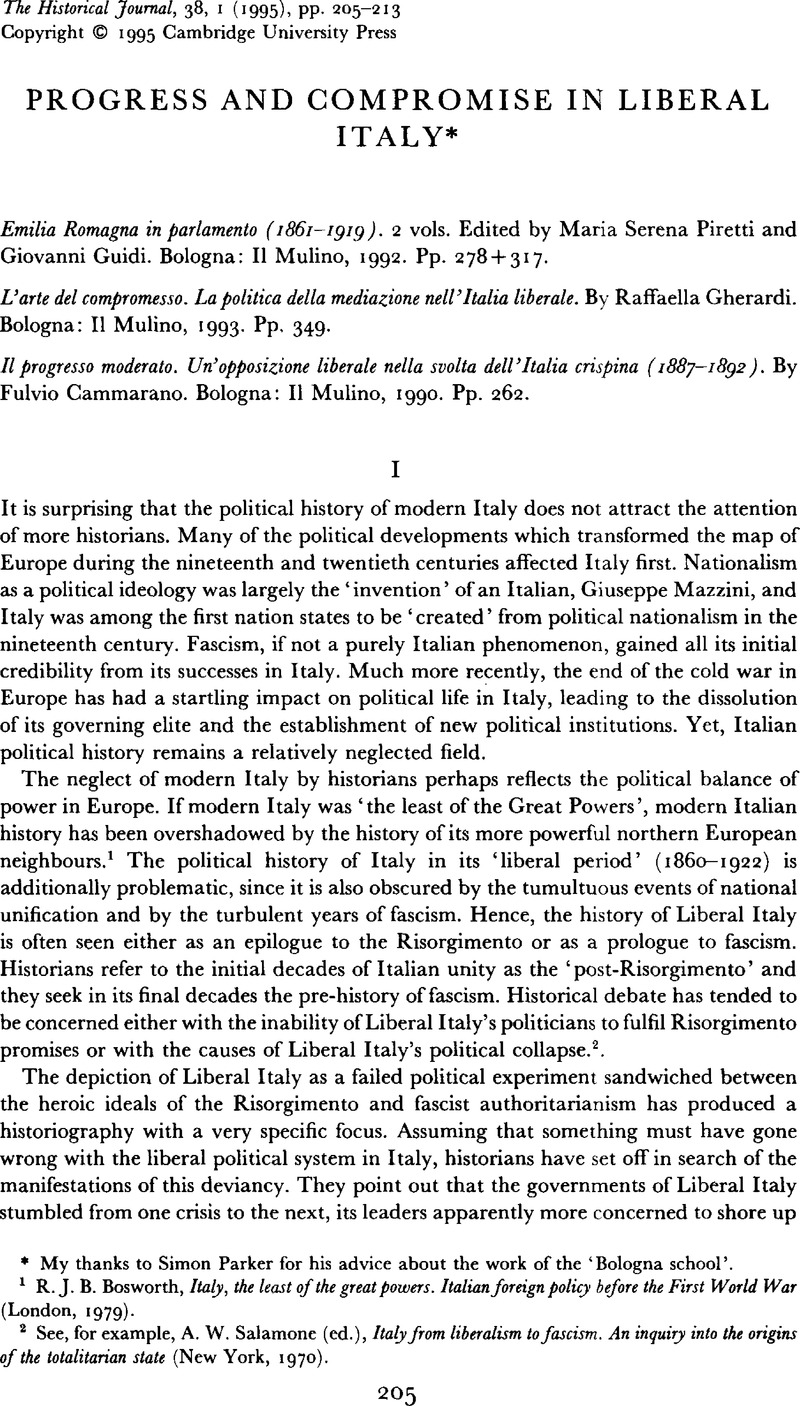Article contents
Progress and compromise in liberal Italy*
Published online by Cambridge University Press: 11 February 2009
Abstract

- Type
- Review Articles
- Information
- Copyright
- Copyright © Cambridge University Press 1995
References
1 Bosworth, R. J. B., Italy, the least of the great powers. Italian foreign policy before the First World War (London, 1979).CrossRefGoogle Scholar
2 See, for example, Salamone, A. W. (ed.), Italy from liberalism to fascism. An inquiry into the origins of the totalitarian state (New York, 1970).Google Scholar
3 The most useful general accounts in English, based on this kind of interpretation, are Watson, C. Seton, Italy from liberalism to fascism (London, 1968)Google Scholar and Martin, Clark, Modern Italy, 1871–1982 (London, 1984).Google Scholar
4 Marxist historians, basing their interpretation on Gramsci's concept of ‘passive revolution’, argued that there were strong lines of continuity between Italian liberalism and Italian fascism. Liberal historians, following Croce's History of Liberal Italy, maintained that there was no connection at all. See Davis, J. A. (ed.), Gramsci and Italy's passive revolution (London, 1979)Google Scholar, Galasso, G., Croce, Gramsci e altri storici (Milan, 1962).Google Scholar
5 For a discussion of the implications of ‘revisionist’ research for the liberal period, see Davis, J. A., ‘Remapping Italy's path to the twentieth century’, Journal of Modern History, LXVI, 2 (1994), 291–320CrossRefGoogle Scholar and Romanelli, R., ‘Political debate, social history and the Italian borghesia: changing perspectives in historical research’, Journal of Modern History, LXIII, 4 (1991), 717–39.CrossRefGoogle Scholar
6 The classic critique of this line of analysis, applied to modern Germany, is Blackbourn, D. & Eley, G., The peculiarities of German history, bourgeois and politics in nineteenth century Germany (Oxford, 1984).CrossRefGoogle Scholar
7 Mayer, A. J., The persistence of the old regime. Europe to the great war (London, 1981)Google Scholar, Eley, G., ‘Liberalism, Europe and the bourgeoisie 1860–1914’, in Blackbourn, D. & Evans, R. J., The German bourgeoisie. Essays on the social history of the German middle class from the late eighteenth to the early twentieth century (London, 1991).Google Scholar
8 Davis, , ‘Remapping Italy's path to the twentieth century’.Google Scholar
9 Riall, L., ‘Liberal policy and the control of public order in western Sicily, 1860–1862’, Historical Journal, XXXV, 2 (1992), 345–68CrossRefGoogle Scholar, Malatesta, M., I signori della terra. L'organizzazione degli interessi agraripadana (1860–1914) (Milan, 1989), pp. 40–50Google Scholar, Romanelli, R., ‘Il problema del potere locale dopo il 1865’, in Romanelli, R., Il comando impossibile: stato et società nell'Italia liberałe (Bologna, 1988).Google Scholar
10 See also Gherardi, R. & Matteuci, N. (eds.), Marco Minghetti, statista e pensatore politico, dalla realtà italiana alia dimensione europee (Bologna, 1986).Google Scholar
11 For research informed by this new perspective, see also C. Pavone, ‘L'awento del suffragio universale in Italia’ and M. Salvati, ‘Dalla Francia all'Italia. Il modello francese e vie surrettizie di modernizzazione amministrativa in uno Stato periferico’, both in Pavone, C. & Salvati, M. (eds.), Suffragio, rappresentanza, interessi. Istituzioni e società fra '800 e '900Google Scholar. Fondazione Lelio e, Lisli Basso, Annali, IX, 1987–1988 (Milan, 1989), 95–121, 123–66.Google Scholar
12 Chabod, F., Storia dell politico estera italiana dal 1870 al 1896, Vol. I. Le premesse (Bari, 1951).Google Scholar
13 Pezzino, P., ‘Monarchia amministrativa ed élites locali: Naro nella prima metà dell'ottocento’Google Scholar, in Pezzino, P., Un paradiso abitato dai diavoli. Società, élites, istituzioni nel mezzogiomo contemporaneo (Milan, 1992)Google Scholar, Scirocco, A., ‘L'amministrazione civile: istituzioni, funzionari, carriere’Google Scholar and Spagnoletti, A., ‘Centri e periferie nello stato napoletano del primo ottocento’, both in Massafra, A. (ed.), Il mezzogiomo preunitario. Economia, società, istituzioni (Bari, 1988)Google Scholar, Rizzi, F., ‘Pourquoi obeir a l'état? Une communauté rurale du Latium aux XVIIIe e XIXe siècles’, Etudes Rurales, CI–CII (1986), 271–87CrossRefGoogle Scholar, Meriggi, M., Amministrazione e classi sociali nel Lombardo-Veneto, 1814–1848 (Milan, 1983).Google Scholar
14 For a theoretical discussion of the processes involved in state formation during this period, see Poggi, G., The state. Its nature, development and prospects (Oxford, 1990)Google Scholar, Dandeker, C., Surveillance, power and modernity (Oxford, 1990)Google Scholar, Mann, M., The sources of social power. Vol. II. The rise of classes and nation-states, 1760–1314 (Cambridge, 1993)Google Scholar, Giddens, A., The nation state and violence (Oxford, 1985).Google Scholar
- 2
- Cited by


